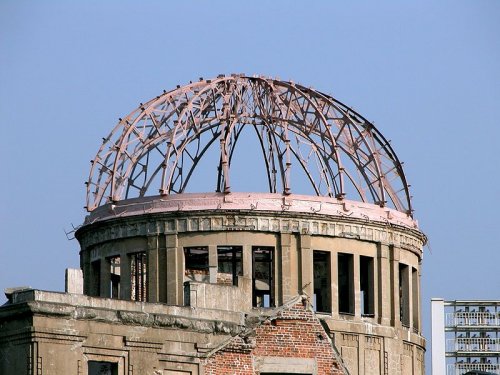Hiroshima (Japanese: 広島市) is a city and capital of Hiroshima Prefecture in Japan. It is the largest city in the Chugoku region in western Honshu.
The city of Hiroshima was founded around 1589. It is located on the delta coastline of the Seto Island Sea. The warlord Mori Terumoto, who established Hiroshima, built his castle here. After he lost the Battle of Sekigahara in 1600, his castle and most of his fiefs was taken over by Tokugawa Ieyasu and given to another daimyo, Masanori Fukushima. The castle later passed to Asano Nagaakira in 1619, and under his leadership, Hiroshima a prosperous town.
In 1871 Hiroshima became the capital of the Hiroshima Prefecture. It was one of the towns where the government set up an English language school in the 1870's. In 1894 a railway line was built to link it to Kobe. Hiroshima gained from the Sino-Japanese War, when the Japanese government temporarily located there. It benefited once again from the Russo-Japanese War of 1904, when it served as a manufacturing base for military supplies.
 Hiroshima, Japan
Hiroshima, JapanSource: http://commons.wikimedia.org/wiki/File:Hiroshima_sky.jpg
Author: Lemon-s

Author: Lemon-s

During the Second World War, the Second Army and Chugoku Regional Army were based in Hiroshima while the Army Marine Headquarters were located at Ujina Port (now Hiroshima Port). These made Hiroshima an attractive target, and on 6 August, 1945, at 8:15 am, the first atomic bomb was dropped on Hiroshima. It killed 80,000 people instantly, while thousands more died in the years to come from injury and radiation. A natural calamity struck Hiroshima the following month, when Typhoon Ida (Makurazaki typhoon), one of the largest typhoons of the Showa period, claimed another 3,000 lives and destroyed what was still standing.
The Hiroshima Peace Memorial Park was created in 1949, and the Hiroshima Prefectural Industrial Promotion Hall became the icon of the name, given the name the "A-Bomb Dome". The designation of Hiroshima as the City of Peace attracted international attention as the choice venue for holding conferences on peace.
Today Hiroshima stands at the forefront in advocating the dismantling of all nuclear weapons.
Planning your trip to Hiroshima
Hiroshima International Airport (HIJ) has regular scheduled flights from domestic destinations as well as some international destinations such as Shanghai, Seoul and Taipei. From the airport, there are buses to downtown Hiroshima. The journey takes 50 minutes and costs ¥1300.You can also reach Hiroshima from Tokyo by train. From Tokyo, you can take the Nozomi Shinkansen (4 hours, ¥17,540) or the Hikari train (5 hours) to the Shin Osaka station. There, you take the Sanyo Shinkansen to Hiroshima (90 minutes, ¥9440).
If you hold the Japan Rail Pass, you cannot use it to take the Nozomi (unless you pay separately for it). Instead you should take the Hikari train and change to the Hikari Rail Star train en route, usually at the Shin-Osaka station.
Planning your travel within Hiroshima
Hiroshima's rapid transit comprises street-level trams or street cars. The hub is at the JR Hiroshima Station. All the stops, entrances and exits are signaged in English. A trip on the trams within the city cost a flat ¥150, except for the line between Hakushima and Hachobori, which is only ¥100. If you take it the whole way to Miyajima, the fare is ¥280. If you are planning to use the tram as your main mode of transport, get the day-pass for unlimited rides for ¥600, or with inclusion of the ferry to Miyajima, at ¥840. A-Bomb Dome, Hiroshima
A-Bomb Dome, HiroshimaSource: http://commons.wikimedia.org/wiki/File:A-bomb_dome_closeup.jpg
Author: Jesse Wilson

Author: Jesse Wilson

Places of Interest in Hiroshima
- Peace Memorial Park
Park with the iconic A-Bomb Dome, now preserved as a World Heritage Site. - Peace Bell
Bell at northern entrance to the Peace Memorial Park. - Memorial Mound
Mound containing the ashes of those who died in the bomb attack and cremated on the spot. - Children's Peace Monument
Monument to children who died in the bomb attack. - Flame of Peace
Torch that will only be extinguished when the last of all nuclear weapons have been eliminated. - Cenotaph
Memorial to the victims of the bomb. - Peace Memorial Museum
Centerpiece of the Peace Memorial Park exhibiting photos and personal accounts of the victims. - Phoenix trees
Trees what were growing 1.5 km from the epicenter, transplanted here to show the scars they still bear from the bomb. - Shukkeien
A garden with pond, stream and miniature bridges. - Hiroshima Castle
Reconstruction of the castle destroyed by the bomb. - Museum of Contemporary Art
Museum designed by Kurokawa Kisho that holds modern and post-war art. - Hiroshima Children's Museum
Museum with lots of hands-on interactive displays.
 Latest updates on Penang Travel Tips
Latest updates on Penang Travel Tips
 Map of Roads in Penang
Map of Roads in Penang
Looking for information on Penang? Use this Map of Roads in Penang to zoom in on information about Penang, brought to you road by road.
Copyright © 2003-2025 Timothy Tye. All Rights Reserved.

 Go Back
Go Back